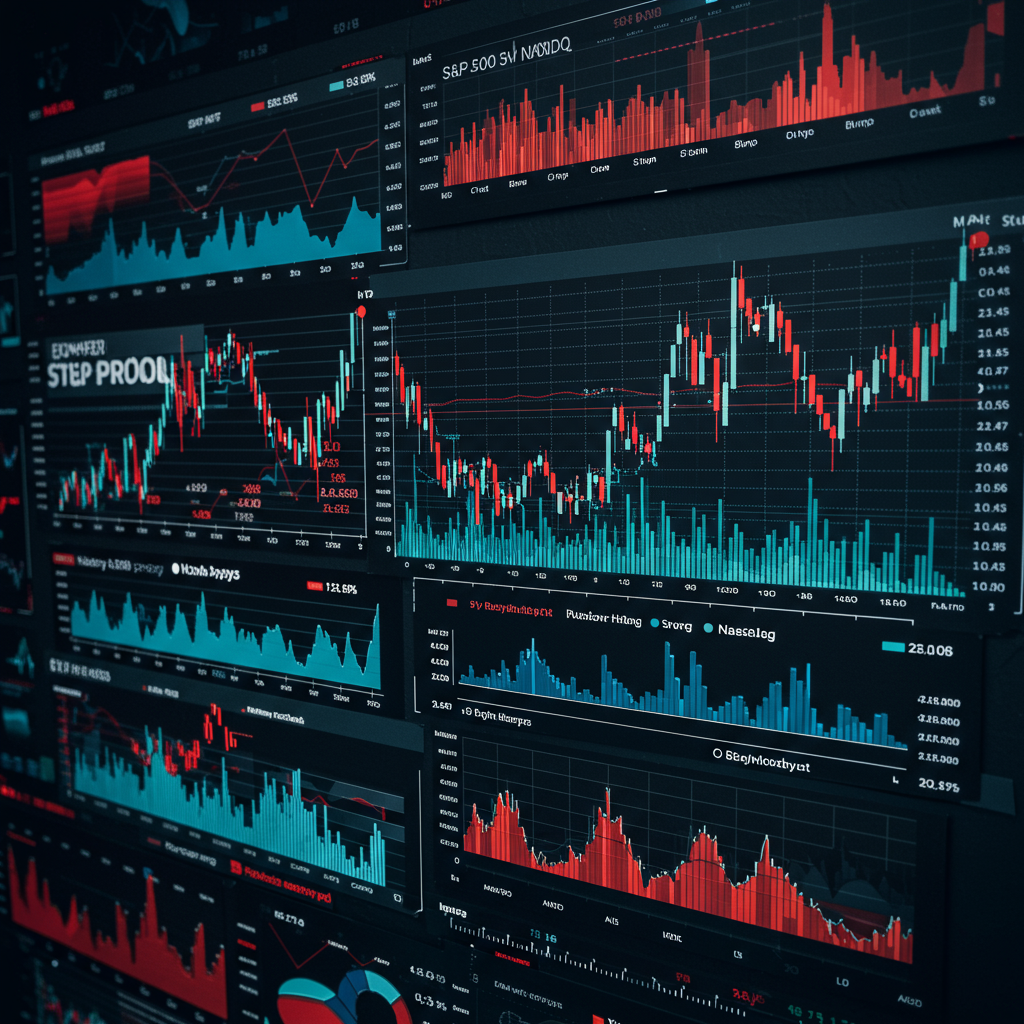U.S. stocks soared to fresh heights in late June and early July 2025, with both the S&P 500 and Nasdaq Composite indexes closing at unprecedented levels. This powerful market surge capped a dynamic second quarter comeback, following a period of earlier volatility. Investors reacted positively to developing trade policies, eagerly awaited critical jobs data, and speculated on the Federal Reserve’s next moves regarding interest rates. Read on to understand the key factors driving this rally and what major investors are signaling about the current market landscape.
Market Indices Hit Historic Highs
The final days of June and start of July 2025 saw major market indices reach new peak performance. On Monday, June 30th, the S&P 500 and Nasdaq Composite both achieved record closing highs. This momentum continued into Wednesday, July 2nd, with both indexes again setting new records, despite more subdued trading volume ahead of the Independence Day holiday.
While the broad market indices climbed, performance was mixed across different benchmarks on certain days. Tuesday, July 1st, saw the Dow Jones Industrial Average gain ground, boosted by healthcare stocks. However, the Nasdaq pulled back slightly on that day, influenced by declines in some large tech names. Meanwhile, the Russell 2000 index of small-cap stocks, which had lagged earlier in the year, showed signs of strength on Tuesday, suggesting a broader participation in the rally.
Key Economic & Political Catalysts
Several significant developments fueled market optimism and influenced investor sentiment during this period. These included progress on trade negotiations, anticipation of crucial economic data, and shifts in legislative focus.
Trade Deal Optimism Builds
Hopes for favorable international trade outcomes played a major role in boosting confidence. Canada notably removed a planned digital services tax targeting U.S. tech firms just before its scheduled implementation. This move aimed to restart stalled bilateral talks. Simultaneously, expectations grew that the U.S. was nearing trade agreements with key partners.
These discussions took place ahead of a looming July 9th deadline. This date was significant as it marked the potential resumption of President Trump’s “reciprocal” tariffs. While the President indicated he might not need to reapply these tariffs broadly, only two formal accords (with China and the UK) were confirmed at the time, with the British deal newly effective. The announcement on Wednesday, July 2nd, of a new U.S.-Vietnam trade deal, which included tariffs on goods from Vietnam and transshipped items, added another layer of complexity and focus on trade policy’s direct market impact. Some market watchers even coined the term “TACO trade” (Trump Always Chickens Out) to describe the perceived tendency for the administration to soften its tariff stance under pressure, further easing trade-related anxieties.
Economic Data Under Scrutiny
Markets were keenly focused on upcoming economic releases, particularly the critical June jobs report, scheduled earlier than usual due to the holiday. Early data provided mixed signals, intensifying the anticipation.
The ADP Research Institute’s private sector jobs report for June showed a surprising contraction, with the U.S. private sector losing 33,000 jobs. This figure sharply missed economists’ projections for job growth and marked the first monthly decline in private employment in over a year. ADP’s chief economist attributed the weakness to hiring hesitation. Conversely, the Job Openings and Labor Turnover Survey (JOLTS) for May showed job openings rising more than expected to their highest level in six months, suggesting persistent labor demand despite cooling hiring and quitting rates. Adding to the mixed picture, the Institute for Supply Management’s (ISM) manufacturing PMI remained in contraction territory at 49, indicating ongoing challenges for manufacturers. These divergent data points created uncertainty about the true state of the economy and its implications for monetary policy.
Federal Reserve Policy Expectations
Speculation surrounding potential interest rate cuts by the Federal Reserve remained a significant market driver. The mixed economic data, coupled with falling Treasury yields, increased optimism that the Fed might consider lowering rates sooner than previously expected.
Fed Chair Jerome Powell, speaking at an ECB forum, acknowledged that the impact of tariffs was increasing inflation forecasts and contributing to the central bank’s patient approach on rates. However, he noted expectations for tariff effects to appear in upcoming data. President Trump continued his public pressure on the Fed and Powell, explicitly calling for a rate cut to 1%. According to the CME Group’s FedWatch tool, futures traders increased the perceived probability of a near-term rate cut following the release of softer economic data like the ADP report.
Legislative Action and Stock Impacts
Major legislative efforts in Washington also captured investor attention and directly influenced specific sectors. The progress of President Trump’s proposed $4.5 trillion “Big Beautiful Bill,” a comprehensive tax and spending package, was a key focus.
The bill narrowly passed a crucial procedural vote in the House and later the Senate, requiring Vice President JD Vance’s tie-breaking vote in the latter chamber. The Senate passage, achieved after marathon voting on amendments, moved the bill closer to a potential July 4th deadline desired by the President. While proponents argued it would boost the economy, the Congressional Budget Office estimated it would add trillions to the deficit over a decade as initially proposed.
Key amendments in the Senate version had distinct market impacts:
An amendment removing a ban on state-level AI regulation reportedly influenced AI chip stocks.
A change softening the phase-out of certain clean-energy tax credits and removing a controversial excise tax on solar/wind projects using Chinese components boosted several solar energy stocks that day, despite the bill still planning to phase out other renewable subsidies post-2027.
Spotlight on Individual Stock Performance
Beyond the index-level movements, several individual stocks experienced significant gains or losses based on company-specific news, sector trends, and the broader economic backdrop.
Technology giants continued their strong performance. Nvidia and Meta both hit fresh record highs, while Microsoft reached an intraday peak. Meta’s surge was partly attributed to CEO Mark Zuckerberg outlining a restructuring of the company’s AI division and ongoing heavy investment in the technology, including deals with AI startups. Alphabet, however, faced a downgrade from BNP Paribas, citing concerns about Gemini AI monetization and potential risks to Search Advertising revenue from new AI features. Apple also saw its stock rise on reports of considering partnerships for its AI features.
The crypto sector and related stocks saw renewed optimism. Robinhood shares surged after launching tokenized stock trading in the EU. Circle, the stablecoin issuer, rose after applying for a national trust bank charter. Other crypto-exposed stocks like Coinbase and MicroStrategy also climbed, partly linked to President Trump’s perceived crypto-friendly stance.
Healthcare saw significant divergence. While UnitedHealth Group performed well, fellow insurer Centene experienced a massive single-day plunge of over 40%. This drastic drop followed Centene’s withdrawal of full-year guidance, citing unexpected increases in Medicaid costs and lower-than-projected growth in health insurance marketplaces in several states. Analysts quickly downgraded the stock, drastically cutting price targets.
Other notable movements included Hewlett Packard Enterprise and Juniper Networks shares jumping after HPE settled an antitrust case, clearing the path for its acquisition of Juniper. Oracle surged after announcing major new cloud service agreements, though news about its previously announced Stargate project with OpenAI remained unclear. Nike benefited directly from the Vietnam trade deal news, given its manufacturing footprint there. In sharp contrast, INmune Bio stock plummeted after its experimental Alzheimer’s drug failed a mid-stage study. Disney shares climbed after an analyst upgrade citing strength across its various businesses.
What Warren Buffett’s Actions Signal
Adding context to the overall market picture, legendary investor Warren Buffett and Berkshire Hathaway’s recent actions offer insights into high-level sentiment. Analysis of Berkshire’s portfolio shows the company has been a net seller of stocks for ten consecutive quarters.
Furthermore, Berkshire’s cash reserves have reached an unprecedented $346 billion as of the first quarter of 2025. At the annual meeting, Buffett explained this massive cash pile isn’t a predetermined goal. Instead, it reflects a simple reality: he hasn’t found enough attractive investment opportunities meeting his strict criteria for value, understanding, and long-term security. His approach is highly opportunistic, waiting for deals that “make sense.” While Buffett hasn’t found broad opportunities, Berkshire has still made targeted investments in companies like Pool Corp. and Domino’s Pizza, businesses he views as having strong competitive “moats.” His actions suggest a cautious stance on the overall market valuation, but also that opportunities for selective, quality investments still exist.
Navigating the Current Landscape
The market’s recent surge to records reflects a complex interplay of factors, from trade hopes and legislative action to anticipation of economic data and central bank policy. While the momentum is strong, risks remain, including potential impacts from trade measures, evolving inflation dynamics, and shifts in economic data trends.
For individual investors, the current environment underscores the importance of a disciplined approach. Warren Buffett’s strategy, while operating on a different scale, offers valuable lessons: patience, a focus on understanding the businesses you invest in, maintaining an emergency fund to avoid forced selling during downturns, and ensuring a well-diversified portfolio of quality businesses. The market’s reaction to individual company news highlights the potential for volatility and the need for careful analysis beyond just index performance. As the market heads into a holiday-shortened week, the June jobs report remains a critical data point that could further influence expectations for the remainder of the year.
Frequently Asked Questions
What major economic report were investors anticipating in early July 2025?
Investors were primarily focused on the official U.S. June jobs report. This key data release was scheduled to be released earlier than usual due to the Fourth of July holiday weekend. Preliminary data, like the surprisingly weak ADP private sector jobs report showing job losses, intensified market attention on the official figures for clues about the labor market’s health and potential impacts on Federal Reserve policy decisions.
How did trade policy, specifically the Vietnam deal and tariff deadlines, influence stock performance?
Hopes for positive trade developments were a significant market driver. Reports of nearing trade deals ahead of a July 9th deadline for potential reciprocal tariffs boosted confidence. The actual announcement of a U.S.-Vietnam trade deal on July 2nd directly impacted stocks like Nike, which has major manufacturing operations in Vietnam, causing its shares to rise. Easing trade tensions, as suggested by the “TACO trade” concept, generally contributed to broader market optimism, although specific tariff provisions could negatively affect certain sectors like solar energy depending on components used.
What does Warren Buffett’s large cash position suggest about the current investment landscape, and how can individual investors apply his principles?
Warren Buffett’s Berkshire Hathaway holds a record $346 billion in cash, having been a net seller of stocks for ten quarters. Buffett indicates this isn’t a market crash prediction but reflects a lack of attractive investment opportunities meeting his stringent value and quality criteria. For individual investors, this suggests patience can be wise and selective opportunities still exist. His principles advise understanding investments, focusing on quality businesses with competitive advantages, maintaining cash reserves for emergencies, and remaining invested long-term despite market volatility.
Word Count Check: 1115




